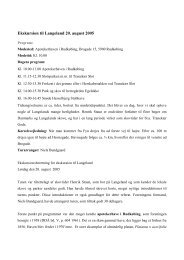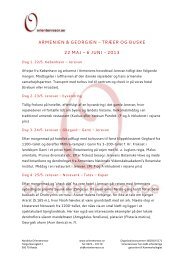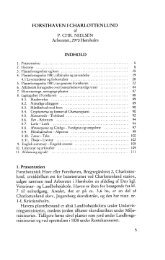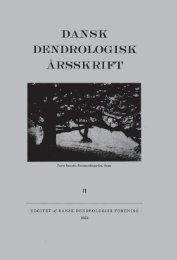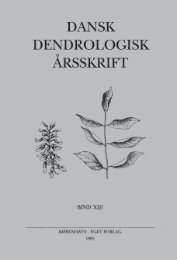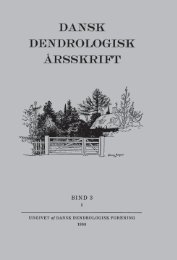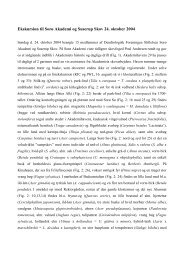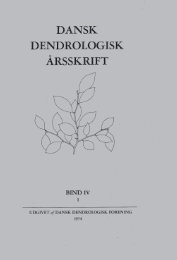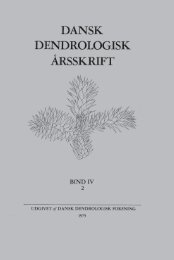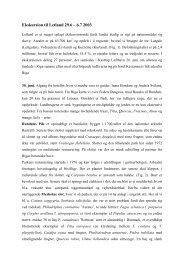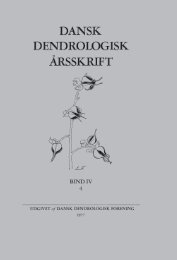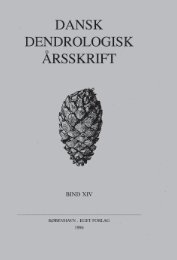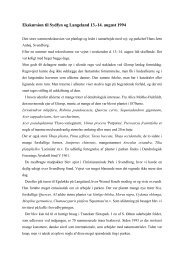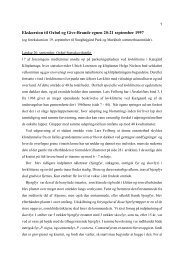Volume 2,1 (1963) - Dansk Dendrologisk Forening
Volume 2,1 (1963) - Dansk Dendrologisk Forening
Volume 2,1 (1963) - Dansk Dendrologisk Forening
You also want an ePaper? Increase the reach of your titles
YUMPU automatically turns print PDFs into web optimized ePapers that Google loves.
anchlets and being a slender and tall tree, reaching 50 m and a<br />
little more, thus at a distance having just the same appearance as<br />
P. Engelmanrii. Like this it grows on the high mountains but<br />
only on dry, often somewhat poor soil, while Engelmanni in typical<br />
specimens stood on rich wet soil along the streams and the drainage<br />
from the snowpatches and between these two types of growing places<br />
there was no end at all in the variation of the intermediate forms only<br />
arranged in such a way, that the nearer we got to the wet growing<br />
places the more dominating grew the Engelmanni-characters and<br />
vice versa. Thus we may conclude that Picea glauca and P. Engelmanni<br />
are two ends of the same complex connected by P. Albertiana,<br />
and I find it reasonable to give them all the range of true species. I<br />
feel convinced that all sorts of intergrades between P. Albertiana and<br />
P. glauca may be found in Alberta and eastwards.<br />
Picea sitchensis and P. Engelmanni never share growing place, the<br />
former being a lowland tree only climbing (along the streams) to a<br />
few hundred m, while the second never descends below 1000 m<br />
above sea level. Between these two altitudes single spruce trees may be<br />
found showing clearly intermediate characters in cones, needles and<br />
bark. I have seen such in the Mount Rainier National Park and near<br />
The Wind River Experiment Station where mr. LEO ISAAC told me,<br />
that there were some curious types of P. Engelmanni far below its normal<br />
ocurrence. I have not been able to solve whether these few trees<br />
have to be considered as hybrids or true intermediates growing in intermediate<br />
altitude; I did not see seeds in the old empty cones nor any<br />
seedlings below the old trees. Further investigations are needed.<br />
Finally I want to postulate that intermediate forms also must exist<br />
between P. Engelmanni and P. pungens. We have had such an intermediate<br />
tree in Charlottenlund Forest Botanical Garden, but it may<br />
of course be the result of seed collection in an arboretum.<br />
Thus I think that we have to deal with 5 distinct but closely allied<br />
species belonging to two different of the taxonomists sections: Eupicea<br />
and Cassicta. The five species may be arranged as follows.<br />
P. sitchensis — P. Albertiana P. glauca<br />
\ It<br />
P. Engelmanni<br />
f<br />
P. pungens<br />
Many other similar cases may be found among other taxonomical<br />
units all over the world.



